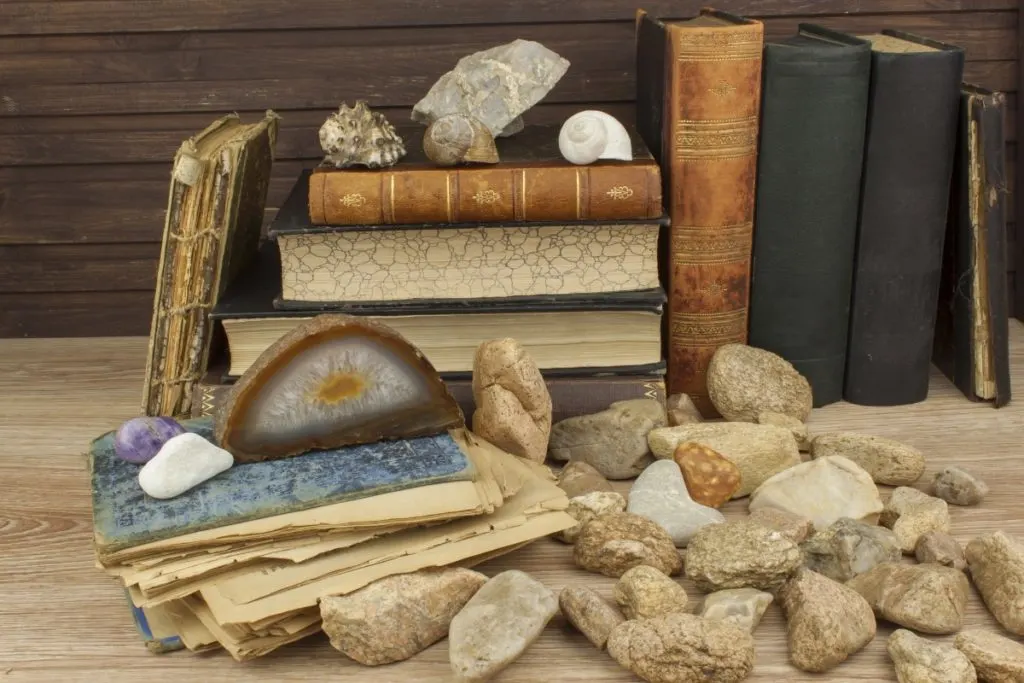The best way to identify the mineral is to consult with a specialist or with a rocks and minerals book. There are dozens of books dedicated to nature, geology, minerals, rocks, and gemstones. However, sometimes books don’t meet our expectations. To help you to avoid fluff books, let us share the best literature with you.
The best books for identifying rocks and minerals are those written by real geologists and mineralogists with scientific or fieldwork experience. Also, books released by academic publishing agencies are more reliable. Just check the information about the author and publisher on the other side of the book.
What is your geological background? Do rocks and minerals are just a hobby for you? Or do you work in the jewelry industry? The time you are fond of minerals and your field of study – are crucial conditions before choosing the right book.
Do you prefer technical and scientific information or you are looking for metaphysical description? There is no one universal book for everybody. We are going to describe the most popular rocks and minerals books as well as the most reliable online sources. And no doubt you will find your mineralogy and rocks identification handbook.

If you are interested in checking out the best books about rocks and minerals identification you can find them by clicking here (Amazon link).
The Best Books for Identifying Rocks and Minerals
It’s challenging to find one book to answer all questions regarding rocks and minerals. Geology is a very broad discipline and has a lot of directions.
For example, volcanology covers volcanoes, eruptions, and different types of rocks created as a result of explosions.
Petrology studies rocks, mineralogy studies minerals, and gemology – gemstones. What do you want to start with? We will help to find perfect literature.
There is no universal rocks and minerals book to cover all needs. It depends on a person’s qualifications and preferences. For those who prefer scientific information – Smithsonian Handbooks: Rocks & Minerals (Amazon link) is a perfect choice. For those who are interested in jewelry – Gem Identification Made Easy (Amazon link) is the best book you can own.
Of course, there is no the-one-and-the-only book that answers all the questions regarding rocks and minerals. But it doesn’t mean that you shouldn’t buy any. It’s better to read just one book than don’t read ten.
Here is a short guide on how to proceed with choosing the minerals and rocks books:
- It’s better to start with something general. For example, books on general geology or Geology 101 will briefly explain the processes of minerals and rock formation.
- Further, you can add something about minerals or rocks if you like crystals or stones.
- Sometimes people are fond of dinosaurs or fossils, so it’s better to choose paleontological literature.
- For an outdoor type of person who likes volcanoes, high cliffs, and huge geo-parks will be useful to check volcanology or sedimentology.
- For those crystal lovers, who are keen on sparkling faceted gems, it’s time to find something gemological (don’t mess it with geology. Gemology is a science of studying precious stones).
- If you like some metaphysics of stones – there is also specific literature for you!
- Also, it’s noteworthy that there are some books for children. Bright pictures and catchy stories will make your child a real young explorer.
Where to Find Best Books for Identifying Rocks & Minerals

Geologists recommend finding the best books for identifying rocks and minerals on
- local Mineral Shows, or
- Museum shops.
Also, geologists are very sociable and are happy to give everybody a good mineral book and even some samples gathered during the last field trip.
So, don’t hesitate to visit the local geoscience faculty or museum to receive the best mineral and rock-related conversation.
At the time of online purchase, we are glad to recommend the list of best books for identifying rocks and minerals.
Best books for identifying rocks and minerals can be purchased on Amazon. Smithsonian Handbooks: Rocks & Minerals, Gem Identification Made Easy and National Geographic Rocks and Minerals (Ages 5-8) and Ultimate Explorer Field Guide (Ages 8-12) for kids are highly recommended to begin with.
Smithsonian Handbooks: Rocks & Minerals
The best rock and mineral book, to begin with, is Smithsonian Handbooks: Rocks & Minerals (Amazon link). It is written by a real scientist and describes more than 500 most common rocks and minerals.
Smithsonian Handbooks: Rocks & Minerals by Chriss Pellant is a perfect book to consult with! It is scientifically based but very easy to understand.
The book is edited by top researchers. More than 500 minerals and rocks are described. It’s more than enough for any qualified rock hunter.
Gem Identification Made Easy
This book (Amazon link) is ideal for gem lovers. The gemstone identification process is thoroughly described by experts. Moreover, it tells how to spot synthetic analogs of gemstones, which have similar chemical composition and physical properties. Prepare your family’s pieces of jewelry to test them all!
Gem Identification Made Easy (6th Edition) (Amazon link) is a book for gem lovers, which is written by true experts in the gem and jewelry field.
The information given is absolutely practical and can be applied to the gem identification process. Moreover, it contains a guide on how to work with basic gemological tools.
TIP: Did you know that one of the common ways to identify rocks is to lick them? Find out why geologists lick the rocks and how to do it in the article below:
Licking Rocks in Geology: Why & How (Answered by Geologist)
Best Books About Rocks for Kids

The best books about rocks and minerals for kids were prepared by National Geographic. Just imagine how beautiful the photos in these books are!
Nobody can withstand captivating stories aligned with professional National Geographic pictures combined with skilled children’s book authors.
The best books about rocks for kids are two National Geographic editions for different ages.
These books will captivate not only a curious child but even a professional geologist. Two different levels will explain everything from very basics to rapid field identification of minerals.
National Geographic: Rocks and Minerals (Age 5-8)
National Geographic: Rocks and Minerals (Age 5-8) (Amazon link) is perfect for a small curious nature lover.
Very basic information is accompanied by captivating pictures of crystals and rocks. Exceptional book to grow an adventurer and explorer written by experienced, skilled children’s book authors.
National Geographic: Ultimate Explorer Field Guide (Age 8-12)
The second National Geographic children’s book – Ultimate Explorer Field Guide (Amazon link), will get kids outside to discover the amazing world underneath their feet.
The book covers all spheres of geology: from paleontology to gemstones. Tons of info and prompts will make your child a true rock hound.
TIP: Most children are fascinated by rocks from an early age. Even if they are not, check out tips on how to get them started in the article below:
Rock Collecting for Kids: 13 Tips How to Get Them Started
Rocks and Minerals Identification Online (Books & Websites)
There are numerous resources online that can help you to identify minerals. They can be just static pages of information or dozens of mineral specimens and rock photos. Nowadays, the most fascinating stuff is provided by universities from all over the world.
You can explore university collections online, check some samples under the microscope, and even try to identify virtual minerals in the virtual lab! Keep going to check the most helpful information to identify minerals and rocks from top universities.
One of the most full mineral information websites, which is widely used by rock hunters, professional geologists, and scientists, is Webmineral. You can check the full list of mineral properties there. GIA – is the website of the Gemological Institute of America and an out-of-competition gemological portal.
There are many other helpful sources for mineral identification. Unfortunately, it doesn’t work the way we can see in science fiction movies when you just take a photo or show a sample to the webcam.
The bulk of work should be completed by the explorer himself. These portals will guide you from all the necessary observations and tests, which should be conducted.
Some online sources are good simulators of mineral identification. So, have fun! Here is the list of online resources from How to Find Rocks.com:
- Minerals.net – a very powerful mineral and gemstone database with physical and chemical properties of minerals and filter search by color, streak, and hardness available.
- Mineral ID A Practical Online Study Guide. Perfect place to train your identification skills.
- Online Lab Gizmos. Mineral Identification. You can observe and measure the properties of a mineral sample (color, luster, shape, density, hardness, streak, and reaction to acid) and then use a key to identify the mineral. There are 26 mineral samples to identify!
- New Path. Another online virtual laboratory.
- Specimen Identification Guide provided by Clemson University.
- Another very nice Identifying Minerals Guide by Lumen.
- The Virtual Rock Box from Illinois Central College.
- DIY Mineral Identification Kit by KU National History Museum and Biodiversity Institute.
- Virtual microscope to check how some rocks and minerals look under magnification.
TIP: Do you know how to properly clean your rocks and minerals? Check out simple and clever ideas on how to do it in the article below:
How to Clean Your Rocks and Minerals: 5 Simple Ideas
Webmineral.com
Sometimes you can find a mineral or rock and have some assumptions about what it could be. After performing some basic observations and simple tests, you need to compare the received information with the known. Webmineral.com is a comprehensive mineralogy database that has all the information needed.
Webmineral is a free mineralogy database that is widely used by rock hunters, explorational geologists, and scientists.
It allows checking all mineral physical properties, chemical composition, crystal forms, and various classifications. Moreover, you can search for minerals by chemical composition.
GIA.edu
An approach to gemstone identification differs from that of minerals. There are stimulants, imitations, and synthetic analogs in the gemstone world.
The best advisor here is a top-quality gem encyclopedia, accompanied by the best peer-reviewed articles which are freely accessible. Enjoy the beauty and science of gemstones with GIA.edu.
GIA – Gemological Institute of America – is a great source to find the newest information about gems. GIA is the world’s foremost authority on diamonds, colored stones, and pearls.
A public benefit nonprofit institute, GIA is the leading source of knowledge, standards, and education in gems and jewelry.
Mineral Identification Key
Mineral Identification Key II by the Mineralogical Society of America gives plenty of essential and well-organized minerals and rock identification knowledge before testing.
Mineral Identification Key II was developed by the Mineralogical Society of America and is an online book to guide you through all the theoretical steps of mineral identification.
Also, using an online identification key and answering some simple questions, you’ll get a list of possible minerals.
Recommendation box: All tools and equipment you need for rockhounding and rock identification* (Amazon links):
1. Estwing Rock Hammer – Light, comfortable, and extremely durable hammer.
2. Estwing Geologist Pick – Classic and the most trusted paleo pick in the world.
3. Finder 12-inch Chisels – Heavy-duty chisels set with hand protection.
4. Mini Handle Shovel – This is a great tool for digging deep in the dirt.
5 Ironclad Utility Work Gloves – Breathable, but they also protect the areas requiring them most.
6. 3M Safety Glasses – Comfortable and efficient goggles for rockhounding.
7. Convoy 8+ UV Light – 365nm UV LED flashlight with a patented glass filter.
8. Wesley’s Jewelers Loupe – High magnification options (30X and 60X) with carrying case.
9. Mohs Hardness Kit – A specially designed kit for rockhounds
*All recommended products are personally tested and regularly used by experts from this website.
Conclusion
Books and online sources are the best partners in minerals and rock identification. Even in times of technology, it’s still vital for a mineral hunter to have a handbook. Sometimes, there is no Internet in the forest.
There is no perfect minerals and rocks book for everyone. The book should be chosen based on personal interest (whether it is geology, volcanology, paleontology, mineralogy, petrology, or gemology) and on geological experience or background.
Here is the list of the books that will come in handy for every mineral and rock lover (Amazon links):
For younger explorers, we recommend National Geographic special editions divided for various ages and written by experienced and skilled children’s book authors (Amazon links):
- National Geographic: Rocks and Minerals (Age 5-8)
- National Geographic: Ultimate Explorer Field Guide (Age 8-12)
Of course, the Internet suggests a lot of helpful resources. The next three are recommended by professional geologists, mineralogists, and gemologists scientists:
- Webmineral.com – a Mineralogy Database
- GIA.edu – free online gem encyclopedia from the leading source of knowledge, standards, and education in gems and jewelry.
- Mineral Identification Key II, created by the Mineralogical Society of America’s best mineralogists.
Keep exploring and reading minerals and rocks literature! And How to Find Rocks.com also suggests high-quality geological content for you every day.
TIP: You know what the best books for rock identification are now. It is time for rockhounding! If you are looking for the best rockhounding tools you can check them out in the article below:
The Complete Guide: All Tools You Need for Rockhounding
